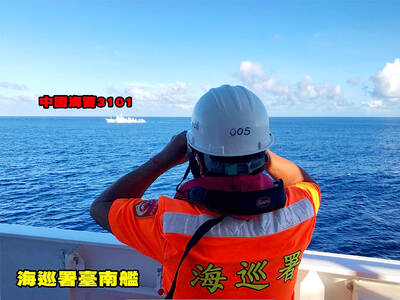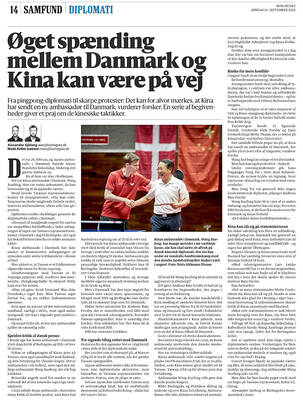Almost half of Taiwanese are getting their news from YouTube, as traditional media outlets scramble for strategies to counter social media's rising influence across the globe, the Reuters Institute's Digital News Report found.
Forty-six percent of Taiwanese respondents said that they used YouTube for news in a survey conducted from mid-January to the end of February, up from 38 percent in 2021, according to the report, which was released on June 17.
Other than Facebook, social media platforms, such as Line, Instagram, Tiktok and Threads, showed growth of 1 to 6 percentage points from the previous year, the report said.

Photo: AFP
Line ranked second among the social media platforms relied on by Taiwanese for news at 42 percent, followed by Facebook, which dropped 2 percentage points to 37 percent, the report said.
Instagram ranked fourth at 14 percent, followed by Tiktok at 10 percent and newcomer Threads at 8 percent.
Traditional media outlets in Taiwan continued to see their popularity as a source for news decline, with TV news at 56 percent this year compared with 77 percent in 2017 and print media falling from 41 percent in 2017 to 14 percent, the report said.
Shrinking advertising income — the result of diminishing popularity — and the changing media environment mean an increasing number of traditional outlets are uploading their video news to YouTube, the report said in its section on Taiwan, which was authored by National Taiwan University professor Lin Lihyun (林麗雲).
Traditional outlets are also adapting long-form stories into short videos for social media, Lin wrote.
Meanwhile, Taiwanese users' trust in news slid 3 percentage points to 30 percent, ranking Taiwan 39th in the 48 markets surveyed in the report.
Taiwan is no different from other countries in terms of media environment and trends, the report found.
Lead author Nic Newman wrote in the executive summary that two emerging themes demand attention: the rise of an alternative media ecosystem including the likes of YouTubers, Tiktokers and podcasters, and the use of artificial intelligence (AI) chatbots as a source of news.
AI chatbots are a source of news for 6 percent of Taiwan's news market, the report found.
An accelerating shift toward consuming news on social media and video platforms is further diminishing the influence of "institutional journalism," Newman wrote, adding that changing platform strategies mean that video continues to grow in importance as a source of news.

The Coast Guard Administration (CGA) yesterday said it had deployed patrol vessels to expel a China Coast Guard ship and a Chinese fishing boat near Pratas Island (Dongsha Island, 東沙群島) in the South China Sea. The China Coast Guard vessel was 28 nautical miles (52km) northeast of Pratas at 6:15am on Thursday, approaching the island’s restricted waters, which extend 24 nautical miles from its shoreline, the CGA’s Dongsha-Nansha Branch said in a statement. The Tainan, a 2,000-tonne cutter, was deployed by the CGA to shadow the Chinese ship, which left the area at 2:39pm on Friday, the statement said. At 6:31pm on Friday,

The Chinese People’s Liberation Army Navy’s (PLAN) third aircraft carrier, the Fujian, would pose a steep challenge to Taiwan’s ability to defend itself against a full-scale invasion, a defense expert said yesterday. Institute of National Defense and Security Research analyst Chieh Chung (揭仲) made the comment hours after the PLAN confirmed the carrier recently passed through the Taiwan Strait to conduct “scientific research tests and training missions” in the South China Sea. China has two carriers in operation — the Liaoning and the Shandong — with the Fujian undergoing sea trials. Although the PLAN needs time to train the Fujian’s air wing and

The American Institute in Taiwan (AIT) put Taiwan in danger, Ma Ying-jeou Foundation director Hsiao Hsu-tsen (蕭旭岑) said yesterday, hours after the de facto US embassy said that Beijing had misinterpreted World War II-era documents to isolate Taiwan. The AIT’s comments harmed the Republic of China’s (ROC) national interests and contradicted a part of the “six assurances” stipulating that the US would not change its official position on Taiwan’s sovereignty, Hsiao said. The “six assurances,” which were given by then-US president Ronald Reagan to Taiwan in 1982, say that Washington would not set a date for ending arm sales to Taiwan, consult

A Taiwanese academic yesterday said that Chinese Ambassador to Denmark Wang Xuefeng (王雪峰) disrespected Denmark and Japan when he earlier this year allegedly asked Japan’s embassy to make Taiwan’s representatives leave an event in Copenhagen. The Danish-language Berlingske on Sunday reported the incident in an article with the headline “The emperor’s birthday ended in drama in Copenhagen: More conflict may be on the way between Denmark and China.” It said that on Feb. 26, the Japanese embassy in Denmark held an event for Japanese Emperor Naruhito’s birthday, with about 200 guests in attendance, including representatives from Taiwan. After addressing the Japanese hosts, Wang